Hicham mziguir, dcom osisoft
- 1. OSISOFT SER VER 2012 SERVER 2012 DCOM CONFIGURATION ifix DCOM CONFIGURATION MS SERVER 2012 Configuring Microsoft server 2012 running OSISoft Pi 2012 talking to SCADA Clients running Windows xp, GE ifix. By Hicham Mziguir 2/6/2013 By: Hicham Mziguir
- 2. Open the Run CMD Hicham mziguir Hicham Mziguir
- 4. TEXT GOES HERE By: Hicham Mziguir
- 6. Terminology In order to understand this interface manual, you should be familiar with the terminology used in this document. Buffering Buffering refers to an Interface Node's ability to store temporarily the data that interfaces collect and to forward these data to the appropriate PI Servers. N-Way Buffering If you have PI Servers that are part of a PI Collective, PIBufss supports n-way buffering. N-way buffering refers to the ability of a buffering application to send the same data to each of the PI Servers in a PI Collective. (Bufserv also supports n-way buffering to multiple PI Server however it does not guarantee identical archive records since point compressions specs could be different between PI Servers. With this in mind, OSIsoft recommends that you run PIBufss instead.) ICU ICU refers to the PI Interface Configuration Utility. The ICU is the primary application that you use in order to configure and run PI interface programs. You must install the ICU on the same computer on which an interface runs. A single copy of the ICU manages all of the interfaces on a particular computer.
- 7. You can configure and run an interface by editing a startup command file. However, OSIsoft discourages this approach. Instead, OSIsoft strongly recommends that you use the ICU for interface management tasks. ICU Control An ICU Control is a plug-in to the ICU. Whereas the ICU handles functionality common to all interfaces, an ICU Control implements interface-specific behavior. Most PI interfaces have an associated ICU Control. Interface Node An Interface Node is a computer on which ď‚· the PI API and/or PI SDK are installed, and ď‚· PI Server programs are not installed. OPC OPC (originated from OLE for Process Control, now referred as open connectivity via open standards) is a standard established by the OPC Foundation task force to allow applications to access process data from the plant floor in a consistent manner. By: Hicham mziguir OPCTool This tool used to be the main tool for testing connection to and supported functionality of OPC Servers. OSIsoft recommends using the PI OPCClient for these purposes and leave the PI OPCTool only as a debugging utility when requested by tech support for troubleshooting specific OPC Server problems with their server vendors. By: Hicham mziguir OPCEnum Tool The OPC Foundation has provided a tool to allow OPC clients to locate servers on remote nodes, without having information about those servers in the local registry. This tool is called OPCEnum and is freely distributed by the OPC Foundation. OPCClient This tool can be used to test connectivity to the OPC Server, and to browse OPC Items and verify data collection. PI API The PI API is a library of functions that allow applications to communicate and exchange data with the PI Server. All PI interfaces use the PI API. By: Hicham mziguir PI Collective A PI Collective is two or more replicated PI Servers that collect data concurrently. Collectives are part of the High Availability environment. When the primary PI Server in a collective By: Hicham mziguir becomes unavailable, a secondary collective member node seamlessly continues to collect and provide data access to your PI clients. PIHOME PIHOME refers to the directory that is the common location for PI client applications. A typical PIHOME is C:Program FilesPIPC. PI interfaces reside in a subdirectory of : Hicham mziguir the Interfaces directory under PIHOME. For example, files for the Modbus Ethernet Interface are in C:Program FilesPIPCInterfacesModbusE. : Hicham mziguir
- 8. This document uses [PIHOME] as an abbreviation for the complete PIHOME directory. For example, ICU files in [PIHOME]ICU. PI SDK The PI SDK is a library of functions that allow applications to communicate and exchange data with the PI Server. Some PI interfaces, in addition to using the PI API, require the use of the PI SDK. PI Server Node A PI Server Node is a computer on which PI Server programs are installed. The PI Server runs on the PI Server Node. PI SMT PI SMT refers to PI System Management Tools. PI SMT is the program that you use for configuring PI Servers. A single copy : Hicham mziguir of PI SMT manages multiple PI Servers. PI SMT runs on either a PI Server Node or a PI Interface Node. pipc.log The pipc.log file is the file to which OSIsoft applications write informational and error messages. While a PI interface runs, it writes to the pipc.log file. The ICU allows easy access to the pipc.log. Point The PI point is the basic building block for controlling data flow to and from the PI Server. For a given timestamp, a PI point holds a single value. A PI point does not necessarily correspond to a "point" on the foreign device. For example, a single "point" on the foreign device can consist of a set point, a process value, an alarm limit, and a discrete value. These four pieces of information require four separate PI points. Service A Service is a Windows program that runs without user interaction. A Service continues to run after you have logged off from Windows. It has the ability to start up when the computer itself starts up. The ICU allows you to configure a PI interface to run as a Service. Tag (Input Tag and Output Tag) The tag attribute of a PI point is the name of the PI point. There is a one-to-one correspondence between the name of a point and the point itself. Because of this relationship, PI System documentation uses the terms "tag" and "point" interchangeably. Interfaces read values from a device and write these values to an Input Tag. Interfaces use an Output Tag to write a value to the device.
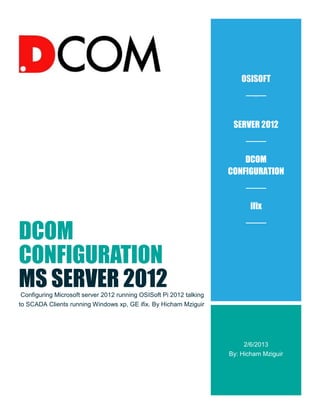

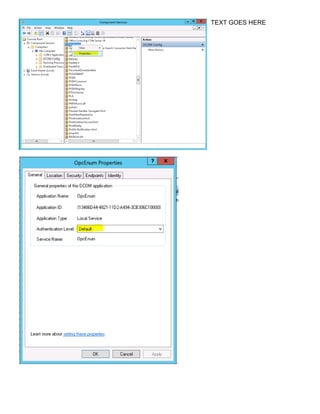

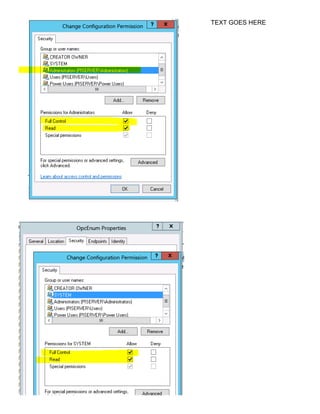
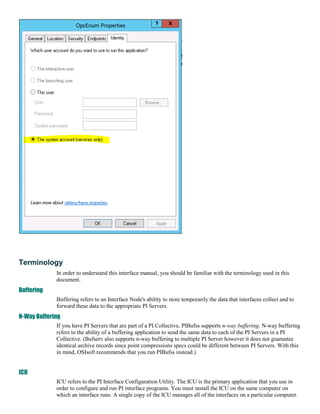
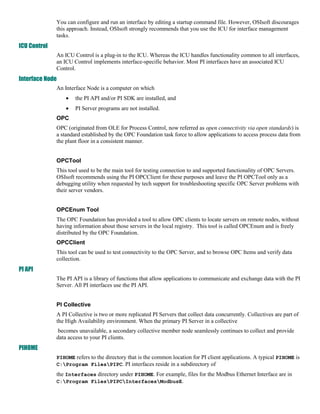
![This document uses [PIHOME] as an abbreviation for the complete PIHOME directory. For example, ICU
files in [PIHOME]ICU.
PI SDK
The PI SDK is a library of functions that allow applications to communicate and exchange data with the
PI Server. Some PI interfaces, in addition to using the PI API, require the use of the PI SDK.
PI Server Node
A PI Server Node is a computer on which PI Server programs are installed. The PI Server runs on the PI
Server Node.
PI SMT
PI SMT refers to PI System Management Tools. PI SMT is the program that you use for configuring PI
Servers. A single copy : Hicham mziguir
of PI SMT manages multiple PI Servers. PI SMT runs on either a PI Server Node or a PI Interface Node.
pipc.log
The pipc.log file is the file to which OSIsoft applications write informational and error messages. While a
PI interface runs, it writes to the pipc.log file. The ICU allows easy access to the pipc.log.
Point
The PI point is the basic building block for controlling data flow to and from the PI Server. For a given
timestamp, a PI point holds a single value.
A PI point does not necessarily correspond to a "point" on the foreign device. For example, a single
"point" on the foreign device can consist of a set point, a process value, an alarm limit, and a discrete
value. These four pieces of information require four separate PI points.
Service
A Service is a Windows program that runs without user interaction. A Service continues to run after you
have logged off from Windows. It has the ability to start up when the computer itself starts up.
The ICU allows you to configure a PI interface to run as a Service.
Tag (Input Tag and Output Tag)
The tag attribute of a PI point is the name of the PI point. There is a one-to-one correspondence between
the name of a point and the point itself. Because of this relationship, PI System documentation uses the
terms "tag" and "point" interchangeably.
Interfaces read values from a device and write these values to an Input Tag. Interfaces use an Output Tag
to write a value to the device.](https://image.slidesharecdn.com/hichammziguirdcomosisoft-130310121126-phpapp01/85/Hicham-mziguir-dcom-osisoft-8-320.jpg)